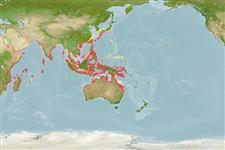Common names from other countries
Classification / Names / Names
आम नाम | उपशब्द | Catalog of Fishes (gen., sp.) | ITIS | CoL | WoRMS
Environment: milieu / climate zone / depth range / distribution range
पारिस्थितिकी
प्रवाल-भित्ति संयुक्त; गहराई सीमा 0 - 12 m (Ref. 100949). Tropical
Indo-West Pacific.
Length at first maturity / आकार / वज़न / Age
Maturity: Lm ? range ? - ? cm Max length : 8.0 cm SHL पुल्लिंग / अलिंग; (Ref. 349); common length : 6.0 cm SHL पुल्लिंग / अलिंग; (Ref. 349)
Regularly collected for food and shellcraft in many countries of the Indo-West Pacific area (Ref. 349). Among rocks and under stones, in rocky shores. Also found in shallow subtidal depths. Sometimes very common (Ref. 349). Feeds on epilithic algae by grazing (Ref. 85382). Found in intertidal, on rocks (Ref. 75835).
Life cycle and mating behavior
परिपक्व अवधि | पुनरुत्पत्ति | मछलीऔ का अंडे देना | अंडे | Fecundity | लार्वा
Members of the order Patellogastropoda are mostly gonochoric and broadcast spawners. Life cycle: Embryos develop into planktonic trocophore larvae and later into juvenile veligers before becoming fully grown adults.
Poutiers, J.M. 1998. (Ref. 349)
IUCN Red List Status (Ref. 130435)
CITES status (Ref. 108899)
Not Evaluated
Not Evaluated
Threat to humans
Harmless
Human uses
मात्स्यिकी: व्यापारिक
| FishSource |
साधन
अधिक जानकारी
Age/Size
बाढ़
Length-weight
Length-length
आकृति विज्ञान
लार्वा
बहुतायत
इंटरनेट स्रोत
Estimates based on models
Preferred temperature
(Ref.
115969): 24.8 - 29.3, mean 28.5 (based on 2592 cells).
Vulnerability
Low vulnerability (10 of 100).
